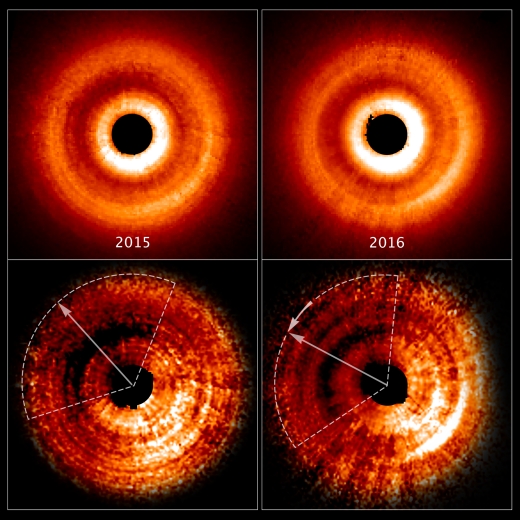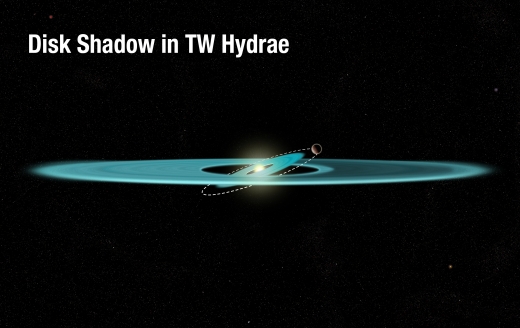One of the great joys of science is taking something that seems beyond reach and figuring out a way to do it. We can use a coronagraph, for example, to screen out much of the light of a star to see planets around it, but coronagraphs can only do so much, as planets too near the star are still hidden from view. Now scientists have used an unusual observation to deduce information about one such hidden planet and its interactions with a circumstellar disk.
Announced at the recent meeting of the American Astronomical Society, the work involves 18 years of archival observations with the Hubble Space Telescope, which have yielded an intriguing shadow sweeping across the disk of the TW Hydrae system. We’re evidently looking at a young planetary system in formation, as the star — slightly less massive than the Sun and about 192 light years away in the constellation Hydra — is only about 8 million years old. Helpfully for our work, the TW Hydrae disk is seen face-on from our perspective.

Image: These images, taken a year apart by NASA’s Hubble Space Telescope, reveal a shadow moving counterclockwise around a gas-and-dust disk encircling the young star TW Hydrae. The two images at the top, taken by the Space Telescope Imaging Spectrograph, show an uneven brightness across the disk. Through enhanced image processing (images at bottom), the darkening becomes even more apparent. These enhanced images allowed astronomers to determine the reason for the changes in brightness. The dimmer areas of the disk, at top left, are caused by a shadow spreading across the outer disk. The dotted lines approximate the shadow’s coverage. The long arrows show how far the shadow has moved in a year (from 2015-2016), which is roughly 20 degrees. Credit: NASA, ESA, and J. Debes (STScI).
We have no other circumstellar disk with an archival dataset this rich, allowing the effect to be studied in depth. John Debes (Space Telescope Science Institute, Baltimore) was able to put observations from Hubble’s Space Telescope Imaging Spectrograph (STIS) together with images from different observing runs, some of which included the Hubble Near Infrared Camera and Multi-Object Spectrometer (NICMOS).
The STIS observations use the instrument’s coronagraph to look close to the star, but the coronagraph still can’t reveal an image of the planet itself. The shadow, however, is another matter. It has swept around the disk counter-clockwise until returning in 2016 to the same position it was in in 2000. The disk’s slow rotation ruled out a feature that was itself a part of the disk, implicating a shadow caused by a tilt to the inner disk relative to the outer. Observations from the Atacama Large Millimeter Array (ALMA) at submillimeter wavelengths backed the idea.
Debes believes a hitherto unseen planet is the most likely cause of the twisted inner disk, pulling material out of the disk plane to block light from the star, thus producing the shadow sweeping across the outer disk. If this is the case, we are talking about a planet roughly 160 million kilometers from the star, too close to observe even with STIS, which can penetrate as close to the star as the orbit of Saturn (roughly 1.5 billion kilometers).

Image: This diagram reveals the proposed structure of a gas-and-dust disk surrounding the nearby, young star TW Hydrae. The illustration shows an inner disk that is tilted due to the gravitational influence of an unseen companion, which is orbiting just outside the disk. Credit: NASA, ESA, and A. Feild (STScI).
To produce the effects Hubble has noted, the planet would need to be about the size of Jupiter. Recent work on TW Hydrae with ALMA has confirmed a gap in the disk about 14.5 million kilometers from the star, perhaps the signature of another planet clearing the inner disk. Thus we are working with a phenomenon that allows us to study early planet formation in an inner system that is otherwise inaccessible, simply by measuring these broad effects.
“What is surprising is that we can learn something about an unseen part of the disk by studying the disk’s outer region and by measuring the motion, location, and behavior of a shadow,” Debes said. “This study shows us that even these large disks, whose inner regions are unobservable, are still dynamic, or changing in detectable ways which we didn’t imagine.”



Suppose that the mass ratio of this planet to its star is 1/1000; that means that the star will swing in a 160,000 km orbit about the planet-star barycenter. That amounts to 17 micro-arc seconds at 192 light years. That is probably just a little small for Gaia to observe, but Gaia should be able to either limit the mass of this proposed planet to a few Jupiter masses, or actually detect it astrometrically, if it should be as massive as (say) 5 Jupiter masses.
Hope this doesn’t mean the starshade is dead…
Its a pity we cant deploy a pair of probes off disc to look for shadows cast by planet nine (or is it ten?) in our ort cloud.
I’m no longtime reader or scientist PhD, but off-disc would be very difficult considering there’s no mass therefore no gravity to use for traveling that is already out there, perpendicular to our solar system’s plane. Supposedly we have done it before….I think it was called Ulysses. We should do it again ASAP.
In the past 24 hours, I have been anguishing over where to post this comment: Here, or somewhere dealing with alien megastructures. I finally chose here because the paper deals with exoplanets. Here goes! HAT-P 67b: An Extremely Low Density Saturn Transiting an F Subgiant Confirmed by Doppler Tomography, by G. Zhou, A. Bakos, J.D. Hartman, D.W. Latham et al. IF this IS a planet, it is BY FAR THE MOST EXTREME EXOPLANET YET! It’s orbital period is 4.81 days. It is the FIRST planet to BREAK the 2RJ boundary(2.085+0.096/-0.071), BUT, what makes this planet(if it IS a planet)SO EXTREME, is that it’s MAXIMUM mass is 0.59 MJ, making it BY FAR the least dense exoplanet in the 2RJ radius range. NOW: This is where I DIVERGE into megastructures. The mass is SO POORLY CONSTRAINED that it could POSSIBLY BE ONLY 0.056MJ, or about 7ME!!! A planet of that COMBINED mass and radius is IMPOSSIBLE, ESPECIALLY ORBITING SO CLOSE TO ITS PARENT STAR? Could this,instead,be a one Earth redius Chthonian remanant planet stripped of its Hydrogen atmosphere when the parent star left the main sequence, now ENCLOSED in a 2RJ MEGABUBLE(think Echo 1 on steriods) to eventually render it habitable? CAVEAT: Since the mass is curently SO POORLY CONSTRAINED at this time, the EXACT mass will be almost certainly near the upper limit, and be classified a Hot Saturn of extremely low density. I am making this comment mainly for the purpose of stating that readers of this website can ACTIVELY PARTICIPATING in SETI by DATA MINING existing research to garner attention to POSSIBLE(however slim) evidence of ETI! Since this object is possibly a result of extra-terestrial TECHNOLOGY, fast-tracted follow-up observations with ESPRESSO to constrain the mass is a MUST!